APPLES - A Safe and Effective Early Intervention for Hand and Arm Use

Key Findings:
This large clinical trial demonstrated that a multi-component, therapist-coached, and parent-administered intervention is safe for developing motor and sensory systems and is effective in improving reaching ability and fine motor skills, and may improve touch perception in the brain for children 6-24 months old with asymmetric CP.
BACKGROUND
Babies with cerebral palsy can have challenges learning new movements, as they have fewer experiences to move and explore.
We hypothesized that a neuroscience-based, multi-component intervention would improve motor skills and sensory processing of the more-affected arm and hand in infants with CP where one side is more impacted than the other (asymmetric CP). In addition, we tested the less-affected side’s function and overall gross motor skills to make sure the intervention was safe.
WHAT HAPPENED IN THE STUDY
We tested our hypothesis in a randomized controlled trial with infants aged 6 months -24 months. All infants had CP affecting one arm and hand (upper extremity) more than the other. In our trial we compared infants with CP receiving the multimodal intervention (37 infants) to infants who were on a short waitlist for the intervention (36 infants). Treatment effects were measured on the more-affected upper extremity and safety effects were measured on the less-affected upper extremity and the whole body. Our measures were computer-calculated smoothness of reach, unimanual fine motor function, and sensory function in the brain. Waitlist infants received only bimanual play during the waitlist period. After the waitlist period ended, the babies who were on the waitlist participated in the treatment.
The intervention was taught to the infants’ parents by a trained occupational or physical therapist and lasted for 4 weeks. On the first visit, the parent and infant met with the therapist to learn the home activities. Then, the parent completed prescribed daily activities 5 days a week. Each week, the parents & infant would meet with the therapist who would coach them on how to advance the activities.The daily activities included:
(1) Wearing a soft-constraint mitt-harness (similar to an oven mitt, except it had a specialized movement sensor in it) on the less-affected upper extremity for 6 hours daily
(2) Reach practice with the more-affected hand using a Velcro mitt
(3) Motor-sensory training with the more-affected hand for increased sensory feedback
(4) Bimanual play (play with both hands)
(5) Structured and supported guidance for parent engagement, with coaching for positive reinforcement and validation of their child’s effortsWHAT WERE THE FINDINGS?
We compared the intervention and waitlist infant groups and found no pretest differences. Most babies wore the constraint for about 38 hours each week and parents demonstrated excellent ability to follow the instructions of the intervention (92% accuracy on fidelity testing).
Effectiveness: APPLES demonstrated improvements in:
• Sensory function - The intervention improved how their hands responded to soft touch, so much that their brain activity was similar to children without CP
• Reaching ability - The intervention significantly increased smoothness of reach, measured by motion capture software
• Fine motor function - The intervention improved fine motor function in the affected hand and for both sides together, measured by standardized assessment of motor skillsSafety was demonstrated by assessing the smoothness of reach and brain activity during sensory stimuli of the less-affected upper extremity before and after the intervention, as well as global gross motor skills. Results showed the less-affected side and gross motor skills were not negatively impacted by the constraint, and the smoothness of reach also improved on the less-affected side after the intervention.
WHY WAS THIS APPROACH SUCCESSFUL?
There are sound reasons why this approach worked: Baby-Constraint Induced Movement Therapy (CIMT) can be done safely with a simple and comfortable restraint. The soft mitt-harness restricts fine manipulation of less-affected hand, but still allows for sensory feedback, full arm range of motion, and use for gross motor skills with the preferred hand. The harness part of the mitt keeps it from falling off even though it is so loose, and the mitt is only worn for 6 hours daily (including naps), usually from wake time through to sometime around early afternoon. This allows for ample time for the child to use both hands. In addition, the approach includes parent coaching for positive engagement, structured reaching training, sensory play, and bimanual training. Finally, the whole intervention is designed to fit during daily routines and playtimes and respects the limits of babies attention span and endurance.
WHAT DOES THIS MEAN FOR FAMILIES?
A multi-component, upper extremity approach with therapist-coaching and parent administration is feasible and effective for infants with asymmetric CP. Tools and toys can be inexpensive and the home exercise can be integrated into family routines. Participating in the APPLES intervention was shown to be safe, it did not affect their use of their less-affected hand or keep them from making progress in their other skills.
FUTURE RESEARCH:
For families of babies 4 months to 13 months old, the new APPLES-tele study is using the same protocol as APPLES, but is comparing the impacts of a positive parenting protocol to the original APPLES protocol, and is assessing is APPLES can effectively be guided remotely (via zoom).
Baby-Constraint Induced Movement Therapy (CIMT) can be done safely with a simple and comfortable restraint.






